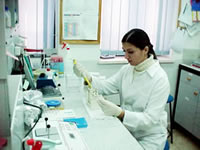Clinical and Genetic Features
Epidermolysis bullosa (EB) encompasses an heterogeneous group of hereditary disorders characterized by blistering of the skin upon exposure to mechanical stress. Although the most obvious signs of the disease are vesicles and bullae within the skin and mucous membranes, internal organs may also be involved (Fine et al, 2000).
EB is traditionally classified in three major groups according to the level of dermal-epidermal separation at the basement membrane (BM) zone. EB simplex (EBS) results from separation of the skin above the BM as a result of basal keratinocyte cytolysis; Junctional EB (JEB) is caused by blister formation within the BM above the lamina densa, while in dystrophic EB (DEB), blisters develop below the BM (Fine et al, 2000; Pulkinnen and Uitto, 1999).
EBS is considered to be the most frequent form of EB with an estimated prevalence of 1:20000 to 1:50000 (Nakano et al, 2000) Three major clinical subtypes have been recognized: Weber-Cockayne subtype mainly affecting the palms and soles; Koebner subtype characterized by a generalized distribution of blisters; and Dowling-Meara subtype presenting at birth with extensive and severe blistering often involving mucosae and nails (Irvine and McLean, 1999).
The molecular cause of EBS was elucidated about 10 years ago. Numerous studies in animal models and humans firmly established that most cases of EBS are caused by mutations in 2 genes encoding keratin 5 or 14 (Irvine and McLean, 1999; Uitto and Pulkinnen, 2001). These two keratin molecules form the bulk of the protein contents of basal keratinocytes and participate as obligatory heterodimers in the formation of the keratin intermediate filaments (KIF) cytoskeleton in these cells. Mutations in either one of the two basal keratin genes affect the ability of the keratin molecules to assemble into a filamentous network and consequently impair keratinocyte capacity to resist mechanical stress, leading to cytolysis and blister formation upon exposure of the skin to friction forces. Severity of the clinical phenotype seems to correlate with the degree to which cellular resilience is compromised (Irvine and McLean, 1999).
Despite marked advances in our understanding of EBS during the last decade, little is currently known about the molecular genetics of the disease in geographic areas outside the US and Europe. Our research study was performed to elucidate the clinical and genetic features of a cohort of Palestinian families affected with EBS.


